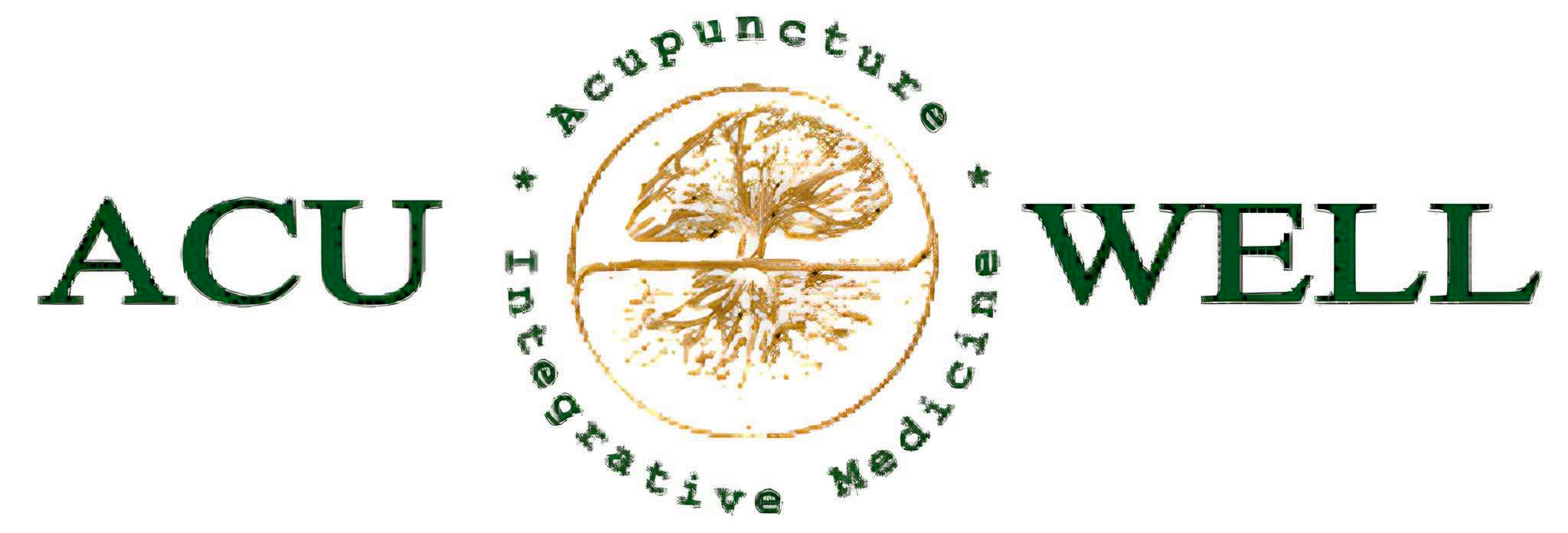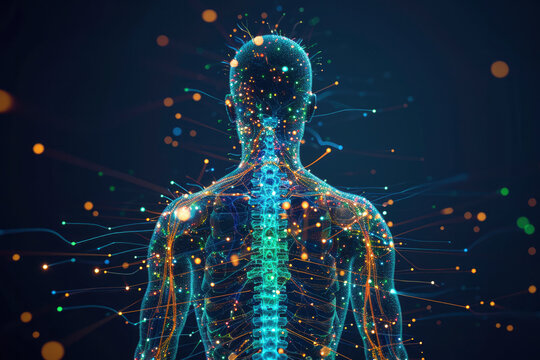 The concept of Qi (sometimes spelled "Chi", pronounced "chee") is fundamental to traditional Chinese medical thought. Qi is the vital energy that gives life to all living matter. There is nothing comparable in allopathic (conventional Western) medicine. While human physiology in allopathic medicine is organized according to specialized function, Chinese medicine is more concerned with the dynamics of the interrelationships, especially the patterns of vital energy.
The concept of Qi (sometimes spelled "Chi", pronounced "chee") is fundamental to traditional Chinese medical thought. Qi is the vital energy that gives life to all living matter. There is nothing comparable in allopathic (conventional Western) medicine. While human physiology in allopathic medicine is organized according to specialized function, Chinese medicine is more concerned with the dynamics of the interrelationships, especially the patterns of vital energy.
 Yin and Yang are counter poles; they are each other's opposite in which life is searching for harmony and balance.
Yin and Yang are counter poles; they are each other's opposite in which life is searching for harmony and balance.




| YIN(陰) | YANG(陽) | |
| Tendency | Extension, dilatation | Contraction |
| Position | Exterior | Interior |
| Direction | Downward | Upward |
| Temperature | Cold | Hot |
| Gender | Feminine | Masculine |
| Element | Water | Fire |
| Season | Cold, winter | Tropical, summer |
| Structure | Space, mass | Time, energy |
| Orientation | Centrifugal | Centripetal |
| Color | Violet, mauve | Red |
| Weight | Easy | Heavy |
| Atom | Electrons | Protons (nucleus) |
| Chemical element | Potassium, Calcium, Oxygen, Azoth, Sulfur, Phosphor, Silicon, Iron, Strontium, Lead, Aluminum, Cobalt, Molybdenum, Tin, Silver, Chlorine | Sodium, Hydrogen, Carbon, Magnesium, Arsenious, Lithium, Quicksilver, Uranium, Neon, Chromium, Nickel, Copper, Palladium, Gold |
| The living world | Vegetal | Animal |
| Plants | Salads, legumes, fruits | Cereals |
| Aliments | that contain much water; | that contain little water |
| rich in potassium; | rich in sodium; | |
| rich in glucides | rich in proteins | |
| Taste | Sour, piquant, peppery, astringent, softly acid, sweet | Salty, bitter, alkaline |
| Nerves | Ortho sympathetic | Para sympathetic |
| Neurochemical Basis | Inhibition | Excitation |
| Vitamins | C,B2,B12,Pp,B1,B6 | D,K,E,A |
| Zodiacal signs | TAURUS, CANCER, VIRGO, SCORPIO, CAPRICORN, PISCES | ARIES, GEMINI, LEO, LIBRA, SAGITTARIUS, AQUARIUS |
| Metabolism | Anabolism | Catabolism |
| Pace | Slow | Fast |
| State | Passivity, static, inertia | Activity, dynamic, movement |
| Sleep | Wake | |
| Blood pressure | Hypotension | Hypertension |
| PH | Acid | Alkaline |
| Humidity | Wet | Dry |
| Other attributes | Expansion | Pressure |
| Quiet | Sound | |
| Low | High | |
| Bigger | Smaller | |
| Long | Short | |
| Horizontal | Vertical | |
| Soft, fragile | Hard | |
| Root | Top | |
| Down | Up | |
| Periphery | Center | |
| Plural | Singular | |
| Subordinated | Leading | |
| Inorganic | Organic | |
| Unruly, unrestrained | Retained, controlled | |
| Earth | Sky | |
| Moon | Sun | |
| Night | Day | |
| Dark | Light | |
| Gas | Solid | |
| Extrovert | Introvert | |
| Woman | Man | |
| Magnetic | Electric | |
| Atomic energy | Nuclear energy | |
| Ultraviolet | Infrared | |
| Short waves | Long waves | |
| Negative | Positive | |
| Concrete | Abstract | |
| Sperm, Spermatozoon | Menstrual blood, Ovule | |
| Bleu, indigo, violet | Red, orange, yellow | |
| Moon | Sun |
 Another basic concept of acupuncture is the Five Elements theory.
Another basic concept of acupuncture is the Five Elements theory.
| Element | WOOD | FIRE | EARTH | METAL | WATER |
| Direction | East | South | Center | West | North |
| Extends Out | Raises | Stabilizes | Inward | Downward | |
| Stage of Development | Birth/Germination | Growth | Transformation | Harvest | Storage |
| Yin - Yang | Lesser Yang | Utmost Yang | Center | Lesser Yin | Utmost Yin |
| Season | Spring | Summer | None | Autumn | Winter |
| Color | Green | Red | Yellow / Brown | White / Black | Black / Blue |
| Zang Organs (Yin) | Liver | Heart | Spleen | Lungs | Kidneys |
| Fu Organs (Yang) | Gall Bladder | Small Intestine | Stomach | Large Intestine | Urinary Bladder |
| Tissue | Tendons / Sinews | Vessels | Muscles | Skin | Bones |
| Disease | Nose Bleeding | Chest Illness | Diarrhea | Malaria similar illness. | Rheumatism or Palsy, cold type |
| Body Part | Head | Chest | Vertebrate | Shoulder & Back | Waist Down |
| Sense | Sight | Words | Taste | Smell | Hearing |
| Sense organs | Eyes | Tongue | Mouth | Nose | Ears |
| Nourishes | Muscles | Blood Vessels | Fat | Skin | Bone |
| Liquid emitted | Tears | Sweat | Saliva | Mucus | Urine |
| Body smell | Rancid | Scorched | Fragrant | Fleshy | Putrid |
| Emotion | Anger; Depression | Joy; Up/Down | Pensiveness; Sympathy; Obsession | Sadness; Anguish; Grief | Fear |
| Expands into | Nails | Colour | Lips | Body hair | Hair |
| Taste | Sour | Bitter | Sweet | Pungent | Salty |
| Climate | Wind | Heat | Dampness | Dryness | Cold |
| Number | 8 | 7 | 5 | 9 | 6 |
| Planet | Jupiter | Mars | Saturn | Venus | Mercury |
| Animal | Fish | Bird | Human | Mammals | Shell-covered |
| Domestic Animal | Sheep | Fowl | Ox | Dog | Pig |
| Grain | Wheat | Beans | Rice | Hemp | Millet |
| Spirit | Hun | Shen | Yi | Po | Zhi |
| Tone | Jue | Zhi | Gong | Shang | Yu |
| Sound | Shouting | Laughing | Singing | Crying | Groaning |
| CHANNEL / POINT | Jing-Well (Wood) | Rong-Spring (Fire) | Shu-Stream (Earth) | Jing-River (Metal) | He-Sea (Water) |
| Liver | Liv1 (H) | Liv2 (S) | Liv3 | Liv4 | Liv8 (T) |
| Heart | H9 (T) | H8 (H) | H7 (S) | H4 | H3 |
| Pericardium | P9 (T) | P8 (H) | P7 (S) | P5 | P3 |
| Spleen | Sp1 | Sp2 (T) | Sp3 (H) | Sp5 (S) | Sp9 |
| Lung | L11 | L10 | L9 (T) | L8 (H) | L5 (S) |
| Kidney | K1 (S) | K2 | K3 | K7 (T) | K10 (H) |
| CHANNEL / POINT | Jing-Well (Metal) | Rong-Spring (Water) | Shu-Stream (Wood) | Jing-River (Fire) | He-Sea (Earth) |
| Large Intestine | LI1 (H) | LI2 (S) | LI3 | LI5 | LI11 (T) |
| Urinary Bladder | UB67 (T) | UB66 (H) | UB65 (S) | UB60 | UB40 |
| Gall Bladder | GB44 | GB43 (T) | GB41 (H) | GB38 (S) | GB34 |
| Small Intestine | SI1 | SI2 | SI3 (T) | SI5 (H) | SI8 (S) |
| Triple-Warmer | SJ1 | SJ2 | SJ3 (T) | SJ6 (H) | SJ10 (S) |
| Stomach | S45 (S) | S44 | S43 | S41 (T) | S36 (H) |
 According to Chinese medicine, the invisible Qi circulates along a system of conduits.
According to Chinese medicine, the invisible Qi circulates along a system of conduits.
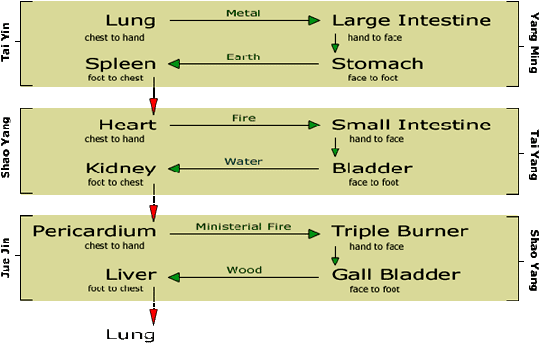



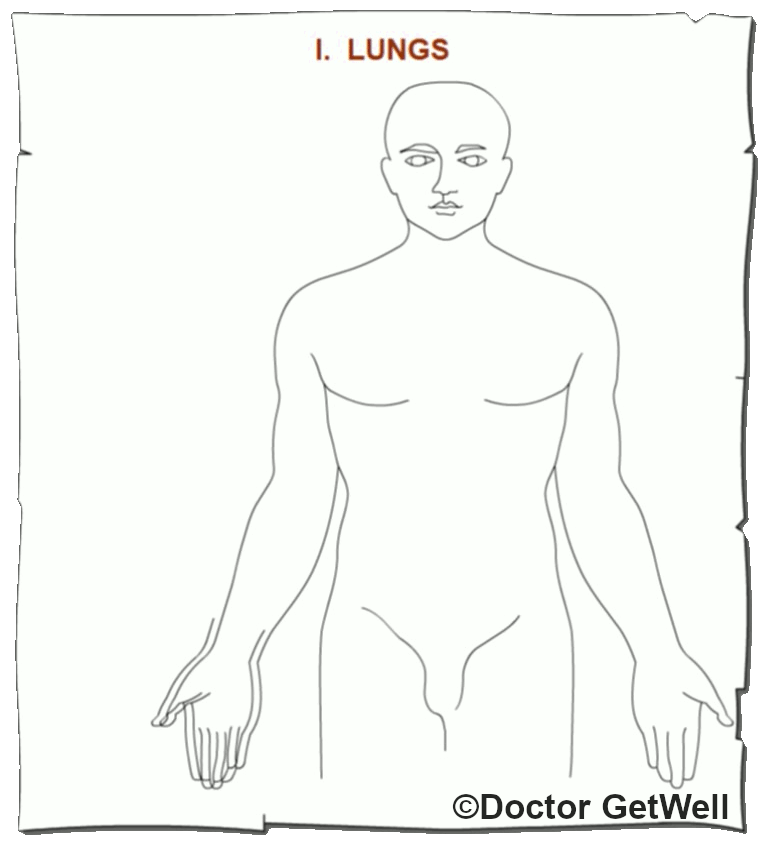
 The 14 main meridians (channels), through which Qi circulates, emerge to the skin surface at the precise locations called acupuncture points.
The 14 main meridians (channels), through which Qi circulates, emerge to the skin surface at the precise locations called acupuncture points.

| CHANNEL / POINT | Jing-Well (Wood) | Rong-Spring (Fire) | Shu-Stream (Earth) | Jing-River (Metal) | He-Sea (Water) |
| Liver | Liv1 (H) | Liv2 (S) | Liv3 | Liv4 | Liv8 (T) |
| Heart | H9 (T) | H8 (H) | H7 (S) | H4 | H3 |
| Pericardium | P9 (T) | P8 (H) | P7 (S) | P5 | P3 |
| Spleen | Sp1 | Sp2 (T) | Sp3 (H) | Sp5 (S) | Sp9 |
| Lung | L11 | L10 | L9 (T) | L8 (H) | L5 (S) |
| Kidney | K1 (S) | K2 | K3 | K7 (T) | K10 (H) |
| CHANNEL / POINT | Jing-Well (Metal) | Rong-Spring (Water) | Shu-Stream (Wood) | Jing-River (Fire) | He-Sea (Earth) |
| Large Intestine | LI1 (H) | LI2 (S) | LI3 | LI5 | LI11 (T) |
| Urinary Bladder | UB67 (T) | UB66 (H) | UB65 (S) | UB60 | UB40 |
| Gall Bladder | GB44 | GB43 (T) | GB41 (H) | GB38 (S) | GB34 |
| Small Intestine | SI1 | SI2 | SI3 (T) | SI5 (H) | SI8 (S) |
| Triple-Warmer | SJ1 | SJ2 | SJ3 (T) | SJ6 (H) | SJ10 (S) |
| Stomach | S45 (S) | S44 | S43 | S41 (T) | S36 (H) |
| Lu | LI | St | Sp | Ht | SI | Bl | K | P | TW | GB | Liv | |
| Wood | 11 | 3 | 43 | 1 | 9 | 3 | 65 | 1 | 9 | 3 | 41 | 1 |
| Fire | 10 | 5 | 41 | 2 | 8 | 5 | 60 | 2 | 8 | 6 | 38 | 2 |
| Earth | 9 | 11 | 36 | 3 | 7 | 8 | 40 | 3 | 7 | 10 | 34 | 3 |
| Metal | 8 | 1 | 45 | 5 | 4 | 1 | 67 | 7 | 5 | 1 | 44 | 4 |
| Water | 5 | 2 | 44 | 9 | 3 | 2 | 66 | 10 | 3 | 2 | 43 | 8 |
| Lu | LI | St | Sp | Ht | SI | Bl | K | P | TW | GB | Liv | |
| Horary | 8 | 1 | 36 | 3 | 8 | 5 | 66 | 10 | 8 | 6 | 41 | 1 |
| Lu | LI | St | Sp | Ht | SI | Bl | K | P | TW | GB | Liv | |
| Tonification | 9 | 11 | 41 | 2 | 9 | 3 | 67 | 7 | 9 | 3 | 43 | 8 |
| Sedation | 5 | 2 | 45 | 5 | 7 | 8 | 65 | 1 | 7 | 10 | 38 | 2 |
| Lu | LI | St | Sp | Ht | SI | Bl | K | P | TW | GB | Liv | |
| Source | 9 | 4 | 42 | 3 | 7 | 4 | 64 | 3 | 7 | 4 | 40 | 3 |
| MERIDIAN | YUAN POINT | LUO POINT |
| Lung | L9 | LI6 |
| Large Intestine | LI4 | L7 |
| Stomach | S42 | Sp4 |
| Spleen | Sp3 | S40 |
| Heart | H7 | SI7 |
| Small Intestine | SI4 | H5 |
| Urinary Bladder | UB64 | K4 |
| Kidney | K3 | UB58 |
| Pericardium | P7 | SJ5 |
| Sanjiao | SJ4 | P6 |
| Gall Bladder | GB40 | Liv5 |
| Liver | Liv3 | GB37 |
| Du Mai | - | Du1 |
| Ren Mai | - | Ren15 |
| Lu | LI | St | Sp | Ht | SI | Bl | K | P | TW | GB | Liv | |
| Xi-Cleft | 6 | 7 | 34 | 8 | 6 | 6 | 63 | 5 | 4 | 7 | 36 | 6 |
| ZANG-FU ORGAN | BACK-SHU POINT | FRONT-MU POINT |
| Lung | UB13 | L1 |
| Pericardium | UB14 | Ren17 |
| Heart | UB15 | Ren14 |
| Liver | UB18 | Liv14 |
| Gallbladder | UB19 | GB24 |
| Spleen | UB20 | Liv13 |
| Stomach | UB21 | Ren12 |
| Triple Warmer | UB22 | Ren5 |
| Kidney | UB23 | GB25 |
| Large Intestine | UB25 | S25 |
| Small Intestine | UB27 | Ren4 |
| Urinary Bladder | UB28 | Ren3 |
| DU MO | ||||
| Master | Couple | Luo | X-Cleft | Points on Meridian |
| SI-3 | BL-62 | DU-1 | ||
| REN MO | ||||
| LU-7 | KI-6 | CV-15 | ||
| CHONG MO | ||||
| SP-4 | MH-6 | CV-15 | KI-21, CV-21, KI-11 | |
| DAI MO | ||||
| GB-41 | SJ-5 | CV-15 | GB-26, GB-27, GB-28 | |
| YIN QIAO MO | ||||
| KI-6 | LU-7 | KI-8 | KI-6, KI-8 | |
| YANG QIAO MO | ||||
| BL-62 | SI-3 | BL-59 | BL-1, BL-59, BL-62, GB-20, GB-29, SI-10, ST-4, ST-3, ST-1, LI-15, LI-16 | |
| YIN WEI MO | ||||
| MH-6 | SP-4 | KI-9 | KI-9, SP-13, SP-15, SP-16, LR-14, CV-22, CV-23 | |
| YANG WEI MO | ||||
| SJ-5 | GB-41 | GB-35 | BL-63, GB-35, GB-13 - 20, DU-15, DU-16, ST-8, SI-10, SI-15 | |
| 3 Arm Yang | SJ-8 |
| 3 Leg Yang | GB-39 |
| 3 Arm Yin | PC-5 |
| 3 Leg Yin | SP-6 |
| Upper Jiao | Middle Jiao | Lower Jiao |
| CV-17 | CV-12 | CV-7 |
| Sea of Blood | BL-11, ST-37, ST-39 |
| Sea of Qi | CV-17, BL-10, ST-9 |
| Sea of Marrow | GV-15, GV-16, GV-19, GV-20 |
| Sea of Nourishment | ST-10, ST-36 |
| "EXTERNAL DRAGONS" | |
| GV-20 | |
| Left | Right |
| BL-11 | BL-11 |
| BL-23 | BL-23 |
| BL-61 | BL-61 |
| "INTERNAL DRAGONS" | |
| CV-15 | |
| Left | Right |
| ST-25 | ST-25 |
| ST-32 | ST-32 |
| ST-41 | ST-41 |
| Lu | LI | St | Sp | Ht | SI | Bl | K | P | TW | GB | Liv | |
| Entry | 1 | 4 | 1 | 1 | 1 | 1 | 1 | 1 | 1 | 1 | 1 | 1 |
| Exit | 7 | 20 | 42 | 21 | 9 | 19 | 67 | 22 | 8 | 23 | 41 | 14 |
| BL-67 |
| KI-7 |
| KI-3 |
| LR-4 |
| SI-4 |
| HT-7 |
| KI-24 |
| Water | BL-44 | KI-24 |
| Metal | LI-8 | LU-3 |
| Earth | ST-9 | SP-4 |
| Fire | HT-4 | HT-7 |
| Wood | GB-24 | LR-14 |
| 3 Arm Yang | GB-13 |
| 3 Leg Yang | SI-18 or ST-3 |
| 3 Arm Yin | GB-22 |
| 3 Leg Yin | CV-3 |
| 3 Arm Yang | GB-13 |
| 3 Leg Yang | SI-18 or ST-3 |
| 3 Arm Yin | GB-22 |
| 3 Leg Yin | CV-3 |
| LI | St | SI | Bl | TW | GB | |
| Lower He-Sea | ST-37 | ST-36 | ST-39 | BL-40 | BL-39 | GB-34 |
| Upper He-Sea | LI-9 | LI-10 | LI-8 |
| BL-10 | MH-1 |
| ST-9 | CV-22 |
| TH-16 | GV-16 |
| LI-8 | SI-16 |
| LU-3 | SI-17 |
| Abdomen | St-36 |
| Head & Neck | LU-7 |
| Back | BL-40 |
| Face & Mouth | LI-4 |
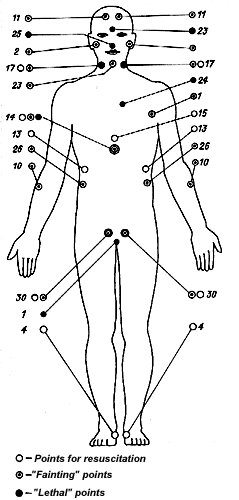


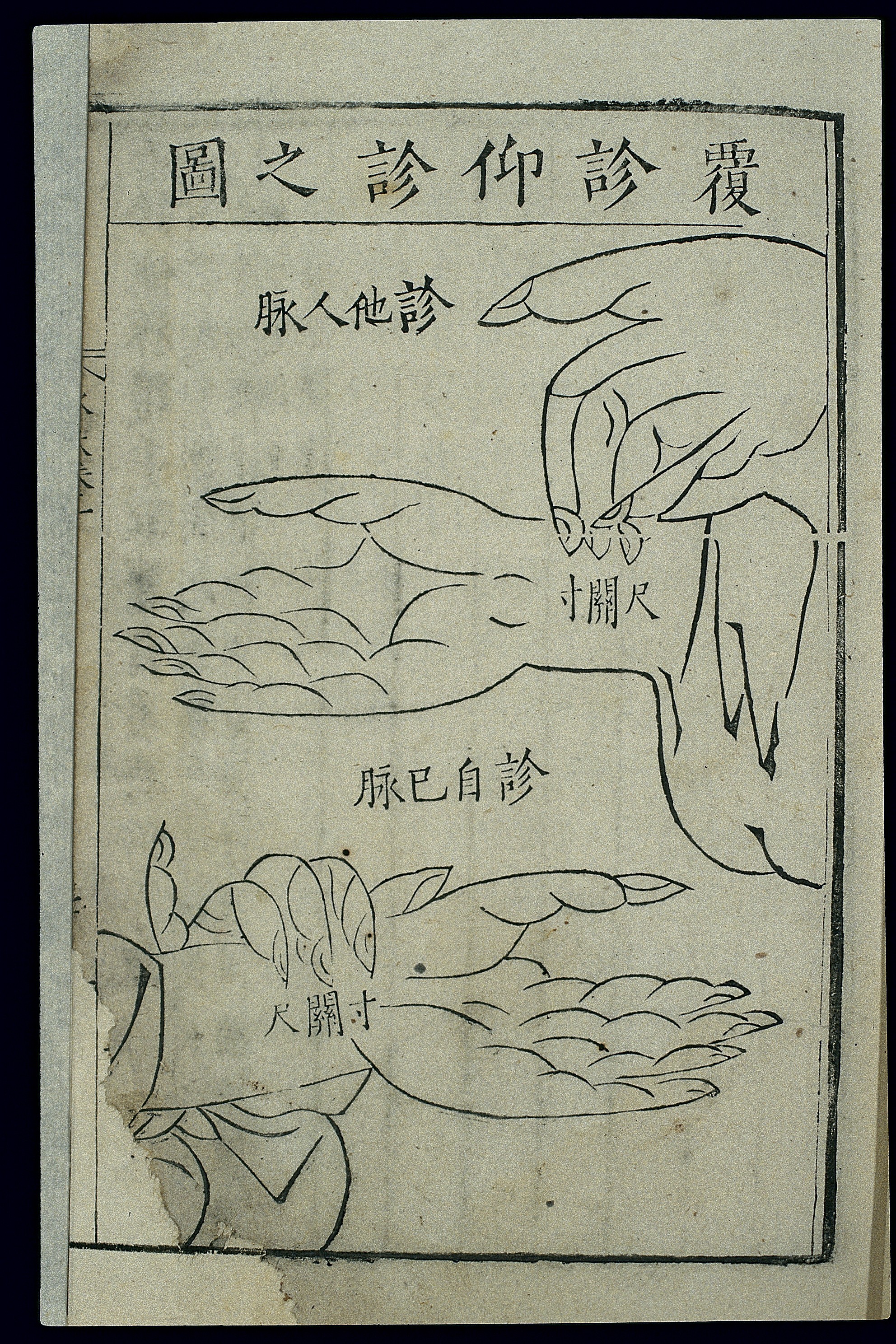 In ancient times, laboratory analyses and tests were not available and acupuncture diagnosis relied mostly on observation.
In ancient times, laboratory analyses and tests were not available and acupuncture diagnosis relied mostly on observation.
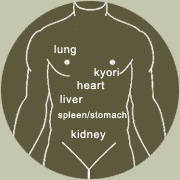 The Zang-fu theory explains the physiological function, pathological changes, and mutual relationships of internal organs.
The Zang-fu theory explains the physiological function, pathological changes, and mutual relationships of internal organs.
 The basic syndromes of traditional Chinese medicine provide foundation for understanding of the nature of disease; signify the location of pathological changes, the condition of body resistance and pathogenic factors.
The basic syndromes of traditional Chinese medicine provide foundation for understanding of the nature of disease; signify the location of pathological changes, the condition of body resistance and pathogenic factors.
